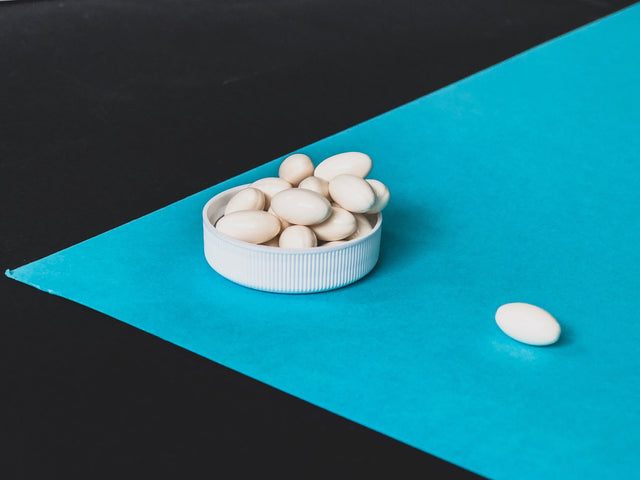Skinny and fat at the same time? Yes! Although not recognized as a traditional medical condition, skinny fat is when a person has very little muscle at a normal weight, yet has a large amount of body fat. A glorified soft body. The problem is that you don’t know what you think you know. Over the years you’ve been taught that fat makes you fat. That endless cardio and rice cakes are a sure-fire way to the svelte life. And that restricting your calories to peas and carrots can get you into a new pair of jeans, where sadness doesn’t exist. We’re going to find out exactly what skinny fat is and why your soft body is fooling everyone out there, besides yourself.
What Is Skinny Fat?
If you find yourself throwing down pizza each week, drinking beer on the daily, skipping meals, and running sporadically to even it out, chances are, you’re skinny fat. Just because we don’t see that power pooch, because you have your Spanx hiked up to your belly button, doesn’t mean it’s not there. Skinny fat is a term that describes people who look fit and thin on the outside, yet due to a poor diet consisting of late-night trips to Taco Bell and a lack of exercise, they have a list of health issues and supplementary body fat. Often times, skinny fat people have a low to moderate body mass index (BMI), yet are more prone to high blood sugar, high cholesterol, and inflammation leading to chronic disease.
RELATED ARTICLE How To Burn Body Fat & Increase Muscle Mass In 4 Simple Steps
You Don’t Eat Enough Or Eat The Right Things
For decades, conventional diets have all said the same thing. Restrict your calories, turn up the cardio, and poof! You’re now magically skinny… fat that is.
One of the biggest misconceptions when it comes to losing weight, is severe calorie restriction. The problem is that you’re not eating enough. Sounds crazy since you’re trying to lose weight, right? Food is your friend, but you have to eat the right foods to maintain long-lasting energy and build lean muscle mass, to raise your basal metabolic rate. So why do conventional diets tell you to restrict calories? Because the Standard American Diet, mainly consists of simple carbohydrates, which sends you on what we call the blood sugar rollercoaster.

The blood sugar rollercoaster refers to spikes and drops in your blood sugar levels, from eating a diet consisting of simple carbs, low to moderate fat, and sporadic protein. If you want to feel great, get rid of food cravings, increase muscle mass, and most of all liquify that skinny fat, it all comes down to blood sugar regulation. Simple carbohydrates or refined carbs are metabolized as sugar. Once they hit your blood stream, they spike your blood sugar level, giving you a short spurt of energy but never really satisfying your hunger. Insulin is dispelled, to try and regulate your blood sugar, which in turn creates more body fat.
RELATED ARTICLE Good VS Bad Carbs: The Difference Between Simple Vs. Complex Carbohydrates
Limiting your calories does help you lose weight, however restricting too much, can lead to added weight gain. Regularly eating fewer calories than your body needs, can cause your metabolism to take a dive. Several studies show that low-calorie diets reduce basal metabolic rate or the amount of calories your body burns by 23% [R, R]. Not only that but slower metabolism can persist long after calorie restriction has stopped, which may explain why so many people regain the weight they’ve lost once they stop their calorie restricted diet [R].
Ensuring that you’re eating enough of the right foods, such as grass-fed lean protein, quality complex carbohydrates, and healthy fats will help you turn your flab into muscle. Check out the table below for a list of food options, to create some healthy meals to make that skinny-fat vanish.
RELATED ARTICLE How To Create An Amazing Meal Plan in 5 Easy Steps
|
PROTEIN |
FUNCTIONAL CARBS |
|
Chicken |
Sweet Potatoes |
|
Turkey |
Brown Rice |
|
Beef |
Whole wheat pasta |
|
Pork |
Whole wheat bread |
|
Tuna |
Quinoa |
|
Salmon |
Apples |
|
Halibut |
Peaches |
|
Steel Head |
Broccoli |
|
Scallops |
Asparagus |
|
Eggs |
Yams |
|
Egg Whites |
Zucchini |
|
Shrimp |
Sqash |
|
Bacon |
Bok Choi |
|
Edamame |
Chic Pea Pasta |
| Whey Protein Isolate | Clean Carbs (Sweet Potato, Yams, Oats, Blueberries) |
Don’t know where to start in creating a nutritious meal plan to shred your skinny fat? Swolverine offers customized and personal performance-driven nutrition coaching at The Swole Kitchen
You Don’t Lift Weights
The more muscle mass you have, the more calories you burn at rest. By incorporating resistance training into your training regimen, you can build more muscle mass and overcome that skinny fat bod. Now, by resistance training I don’t mean going to the gym then jumping from machine to machine, while you’re on your phone scrolling through your Instagram feed. I mean actually lifting weights. The best place to start, is with compound movements.

Compound movements involve multiple joints and stimulating more than one muscle group at a time. Exercises and lifts such as (Deadlifts, Push Press, Bench Press, or Back Squat) provide for a better workout because they stimulate all your major muscle groups at once. This means that you’ll build the greatest amount of muscle mass and strength, in the shortest period of time. Even without heavyweight, compound movements at a high-volume will still help you get stronger, and burn that skinny-fat flab faster than simply using isolated movements such as bicep curls or exercise machines.
If you want to get that Chris Hemsworth or Adriana Lima body, then you’re going to need to work for it. Don’t be lazy! Effort in, equals effort out. If you don’t get your heart rate up for at least 20-45 minutes per session, you might as well put your spanx back on. In order to shred fat, you need to be in your ‘fat-burning zone’ which is (67.6-87.1% maximal heart rate) [R].
Excess Post Exercise Oxygen Consumption (EPOC)
After strength training, your metabolism stays elevated through a process called excess post-exercise oxygen consumption (EPOC). EPOC also know as the afterburn effect, refers to the oxygen and energy (in calories) it takes for your body to repair your muscle tissue during recovery. EPOC can be a major contributor to your total daily caloric expenditure by increasing your body’s thermic effect [R]. Prolonged workouts with more intense resistance training at heavier weights have been associated with a more substantial EPOC [R].
RELATED ARTICLE How to Get Stronger In 3 Simple Steps
You Do Too Much Cardio
Cardio is great, but you know what’s even better? High-intensity interval training (HIIT) Traditional cardio (running, cyclying, elliptical-ing) don’t help you build more muscle mass. But, HIIT will help take you from skinny fat, to shredded.
High-intensity interval training (HIIT) is a mode of exercise training that consists of resistance and circuit training. HIIT is one of the best exercise methodologies to burn body fat. By incorporating lightweights with circuit training, you can successfully elevate your heart rate while increasing muscle mass through moderate load resistance training.

An example would be 10 burpees immediately followed by 10 push-press, air squats, and finished off with 10-meter sprints. Of course, there are hundreds of variations and workouts you can perform, HIIT is a great way to get your cardio in without the monotony.
Research has shown that HIIT can optimize body composition by reducing body fat, optimizing lipid profiles and improving aerobic and anaerobic performance. Incorporating HIIT training in your weekly routine can help you achieve your goals of shredding body fat and building lean muscle mass. Pairing resistance training with a HIIT workout will help elevate heart rate and burn more body fat. Remember, the more intense the workout the more substantial your EPOC, especially when paired with compound movements.
Why Are You Skinny Fat: Takeaway
The bottom line, is that recognizing you need to implement a change is the first step. The second step is creating a plan. By creating a customized meal plan that incorporates quality lean proteins, complex carbohydrates, and healthy fats you’ll start shredding fat, in no time. But remember, that can go two ways. If you’re not eating enough and skipping meals, then start eating more well-balances meals throughout the day to raise your metabolism. If you want to find out what your target caloric intake should be then can go https://www.calculator.net/calorie-calculator.html. This will give you a baseline of how many calories you should be generally eating per day, to keep your metabolic rate in the right range. If you’re eating too much, of the wrong things like simple carbs, then cut your calories to what your caloric intake should be, and replace those refined sugars with quality whole foods. Last but not least, you need to physically lift weights. Whether you work out in the garage, or at Gold’s Gym, it doesn’t matter. Getting your heart rate into your fat-burning zone, will ensure you melt that skinny fat right off your body.
SIGN UP NOW
SWOLVERINE is an endurance athlete and active lifestyle brand. Made for the elite athlete, and the strong-willed our products were designed to fuel your athletic performance. We perform when you perform.
We believe that everyone can optimize not only their athletic performance but their human potential. The way we believe we can optimize performance is through transparency, clinically effective doses, and clinically proven ingredients with evidence-based outcomes. We provide the nutrients you need to power your active lifestyle.
References
Carey DG. Quantifying differences in the "fat burning" zone and the aerobic zone: implications for training. J Strength Cond Res. 2009;23(7):2090-5.
Laforgia J, Withers RT, Gore CJ. Effects of exercise intensity and duration on the excess post-exercise oxygen consumption. J Sports Sci. 2006;24(12):1247-64.
Børsheim E, Bahr R. Effect of exercise intensity, duration and mode on post-exercise oxygen consumption. Sports Med. 2003;33(14):1037-60
Ouerghi, Nejmeddine et al. “Effects of high-intensity interval training on body composition, aerobic and anaerobic performance and plasma lipids in overweight/obese and normal-weight young men.” Biology of sport vol. 34,4 (2017): 385-392. doi:10.5114/biolsport.2017.69827
Fothergill E, Guo J, Howard L, et al. Persistent metabolic adaptation 6 years after "The Biggest Loser" competition. Obesity (Silver Spring). 2016;24(8):1612-9.
Müller MJ, Bosy-westphal A. Adaptive thermogenesis with weight loss in humans. Obesity (Silver Spring). 2013;21(2):218-28.







